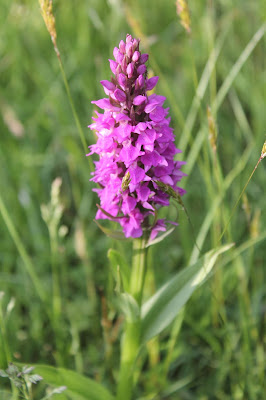On the western slopes of Coity mountain above Blaenavon is a hitherto unexplored landscape of semi -improved meadows, disused farm buildings, remnant drystone walls and a scattering of mature trees. Where the ffridd habitat bleeds into the marginal farmland is a new patch for me, emphasising that even a lifetime of observing local wildlife it's still possible to find areas untouched by the childlike curiosity of a valley naturalist.
At the Garn lakes Local Nature Reserve (LNR) north car park I pushed my way into a small flower rich meadow where a couple of ponds augment the reassuring scruffiness of this mass of tangled botany. Struck by the hundreds of southern marsh orchid I paused to watch around half a dozen four-spotted chaser dragonfly using the pond, here too some well meaning individual has introduced a white water lily. When photographing a stand of ragged robin and lesser stitchwort I felt something crawling through my hair it was the long horned beetle Rhagium mordax.

Back on the road westwards pass the Whistle Inn with its raucous inhabitants and onwards past the adjacent camping and caravan site where some campers were sitting out enjoying the warm late evening sun, I turned south through a metal gate. A farm track and public footpath avenue was flanked by drystone walls and scattering of stunted hawthorn trees some in flower. The view from this point had a calming influence and offered a new perspective on this part of Blaenavon. Here an agrarian landscape with it's backdrop of spoil tips characterised the variety contained herein.
Through a very large stand of Japanese knotweed I found the remains of a farm building with a line of mature plum trees and a bolted rhubarb plant with its rosette of large leaves. Beyond and through binoculars I could see a field of scattered orchids and yellow rattle and a frenzy of flying invertebrates silhouetted against the June setting sun.
The track at this point was shadowed by trees on both sides but not dark enough to prevent about half a dozen heath spotted orchid from flowering. Back in the open sunshine a small wetland flush supported lesser spearwort; a tree pipit was singing in the distance. Shutting another squeaky metal field gate the footpath took me through a field of horses feeding a safe distance away, but all raised their heads in unison to check me out as I got closer. The horses eventually continued grazing and I reached an impressive disused farm building unmolested. But what an idyllic location! The large structure with its small cottage windows evoked images of children playing, their mother keeping a watchful eye in her floral pinny and father in flat cap drinking a mug of cider -stereotypical I know. A quick rummage through a decaying pile of timber produced a stand of white stonecrop. I retraced my footsteps knowing that I would return to this spot again and hopefully before the summers out.
